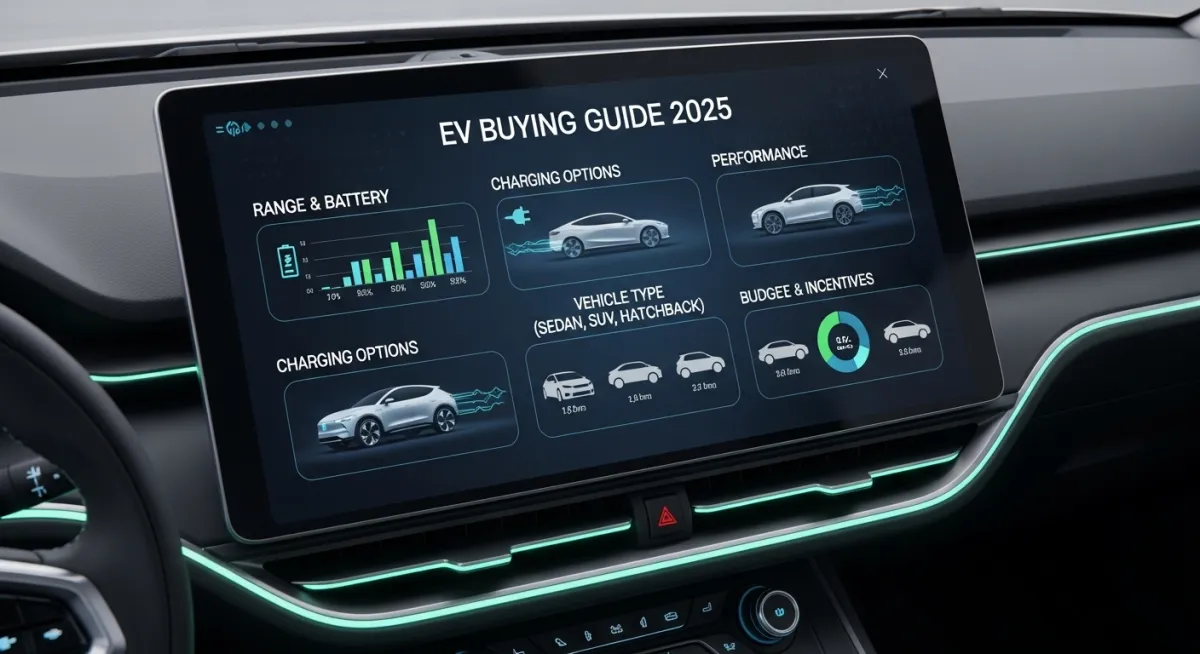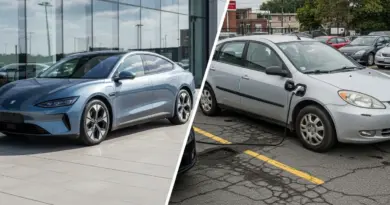EV Buying Guide 2025: How to Choose the Right Electric Vehicle for Your Needs
Last Updated on September 29, 2025 by Team Eletric Car
In 2025, the best electric vehicles offer ranges up to 500 miles, starting prices from $30,000, and potential savings via expiring tax credits up to $7,500—focus on models like the Hyundai Ioniq 6 for efficiency or Tesla Model Y for versatility to match your daily commute and budget.
With federal EV tax credits ending September 30, 2025, buyers should act quickly to secure rebates on qualifying new electric vehicles, while used options provide up to $4,000 credits, making now an ideal time to transition for long-term fuel and maintenance savings.
Introduction to Electric Vehicles
Electric vehicles (EVs) have become mainstream in 2025, powered entirely by batteries instead of gasoline, offering a cleaner, quieter drive. These cars use electric motors for instant torque, meaning quick acceleration without the noise of traditional engines. For beginners, think of an EV as a smartphone on wheels—it charges overnight at home and runs on electricity from the grid or renewable sources like solar panels.
The rise of EVs stems from environmental concerns, with zero tailpipe emissions reducing carbon footprints. In 2025, sales have surged 35% year-over-year, driven by improved battery technology and expanding charging networks. Popular models include compact sedans for city driving and spacious SUVs for families, all benefiting from over-the-air software updates that add new features without visits to the mechanic.
Types of Electric Vehicles Available in 2025
Understanding the varieties helps narrow choices. Battery electric vehicles (BEVs) run solely on electricity, like the Tesla Model 3, with no gas backup. Plug-in hybrid electric vehicles (PHEVs) combine a battery for short trips with a gas engine for longer ones, such as the Toyota Prius Prime.
Fuel cell electric vehicles (FCEVs), like the Honda Clarity, use hydrogen to generate power, but they’re rarer due to limited refueling stations. In 2025, BEVs dominate with 80% market share, thanks to better range anxiety solutions and falling battery costs.
Key Factors to Consider When Buying an EV
Selecting the right electric vehicle involves evaluating daily needs. Start with lifestyle: commuters might prioritize battery range, while families need cargo space.
Budget and Pricing for EVs in 2025
EV prices range from $30,000 for entry-level models like the Fiat 500e to over $100,000 for luxury options like the Lucid Air. Average cost is $45,000, down 10% from 2024 due to competition. Factor in total ownership: electricity costs $0.15 per kWh versus $4 per gallon gas, saving $1,500 yearly.
Incentives play a big role—federal credits up to $7,500 for new EVs under $80,000 MSRP for SUVs, but they expire soon. State rebates add $1,000–$5,000, and leasing often qualifies for full credits.
Range and Battery Life Expectations
Battery range is crucial; most 2025 EVs offer 250–400 miles per charge, with the Porsche Taycan hitting 500 miles. Real-world factors like cold weather reduce this by 20–30%. Look for EPA ratings: the Hyundai Ioniq 6 tops at 361 miles.
Battery warranties cover 8–10 years or 100,000 miles, retaining 70% capacity. Degradation is minimal—about 2% per year—with tips like avoiding full charges daily extending life.
Charging Infrastructure and Options
EV charging comes in levels: Level 1 uses standard outlets for 4–5 miles per hour, ideal for overnight. Level 2 home chargers add 25–30 miles per hour, costing $500–$1,000 to install.
Public DC fast chargers deliver 100–350 kW, adding 200 miles in 20 minutes. Networks like Electrify America and Tesla Superchargers have grown 35% in 2025, with 50,000+ stations nationwide. Plug-and-charge tech simplifies payments starting 2025.
Performance, Safety, and Tech Features
EVs excel in performance with 0–60 mph times under 4 seconds for models like the Hyundai Ioniq 5 N. Safety includes regenerative braking for better control, and features like autopilot in Teslas.
Tech integrations: Apple CarPlay, Android Auto, and voice assistants make driving intuitive. Look for over-the-air updates for ongoing improvements.
Top Electric Vehicles to Buy in 2025
Based on tests, here are standout electric cars across categories.
Best Compact EVs
The Tesla Model 3 offers 272–341 miles range, starting at $40,000, with autopilot standard. Hyundai Ioniq 6 provides sleek design and efficiency.
Best Electric SUVs
Tesla Model Y leads sales with 358 miles range and family-friendly space. Chevrolet Equinox EV is budget-friendly at $35,000.
| Model | Key Specs |
|---|---|
| Tesla Model Y | 358 miles range, $45,000, AWD option |
| Hyundai Ioniq 5 | 303 miles, $42,000, fast charging |
| Ford Mustang Mach-E | 300 miles, $40,000, sporty handling |
| Kia EV6 | 310 miles, $43,000, quick acceleration |
| Chevrolet Blazer EV | 279 miles, $48,000, spacious interior |
This table compares popular electric SUVs by range and price.
Best Luxury EVs
Lucid Air boasts 516 miles range for $70,000+. BMW iX focuses on comfort.
Pros and Cons of Owning an EV in 2025
Weighing benefits against drawbacks is essential.
Pros:
- Cost Savings: Lower fuel and maintenance—save $10,000 over 5 years versus gas cars.
- Environmental Impact: Zero emissions, supporting green energy.
- Quiet and Smooth Ride: No engine noise, instant power.
- Home Charging Convenience: Plug in like a phone.
- Tax Incentives: Up to $7,500 credits until end of September.
- Tech Perks: Advanced safety and infotainment.
Cons:
- Upfront Cost: Higher initial price, though dropping.
- Charging Time: Home charging takes hours; fast options limited in rural areas.
- Range Limitations: Shorter in cold weather or highways.
- Battery Replacement: Rare but costly after warranty.
- Infrastructure Gaps: Not all areas have ample stations.
- Depreciation: Faster than gas cars, though improving.
EV Incentives and Tax Credits for 2025
Federal EV tax credits provide up to $7,500 for new vehicles meeting battery sourcing rules, but end September 30. Used EVs get $4,000 if under $25,000 and from dealers.
State programs vary: California offers $2,500 rebates. Check eligibility via IRS tools.
How to Test Drive and Purchase an EV
Visit dealerships for test drives—focus on acceleration, handling, and interface. Online configurators from Chevy or Tesla help customize.
Financing: Leases often include credits; loans have low rates for green vehicles. Buy used for savings, inspecting battery health.
Maintenance and Long-Term Ownership Costs
EVs need less upkeep—no oil changes, fewer brakes due to regen. Annual costs average $500 versus $1,000 for gas cars.
Tires wear faster from weight; insurance might be 10% higher. Resale value improves with better batteries.
Insurance and Resale Value for EVs
Shop quotes—EVs often cost more to insure due to repair prices, but discounts for safety features help. Resale: Models like Tesla hold 60% value after 3 years.
Environmental and Sustainability Aspects
EVs cut emissions by 50–70% over lifecycle, especially with renewable grids. Recycling batteries reduces waste.
Common Mistakes to Avoid When Buying an EV
Don’t overlook home charging setup costs. Overestimate range needs—most drive under 40 miles daily. Ignore software ecosystem compatibility.
Future Trends in Electric Vehicles for 2026 and Beyond
Expect solid-state batteries for 600-mile ranges, wireless charging, and more affordable models under $25,000.
Conclusion: Making Your EV Purchase Decision
In 2025, the right electric vehicle balances needs with features. With credits expiring, research top models like the Ioniq 6 or Model Y, test drive, and calculate savings for a smart buy.
FAQs
What is the average range of electric vehicles in 2025?
Most EVs offer 250–400 miles per charge, with luxury models exceeding 500 miles, depending on battery size and driving conditions.
How much do electric vehicles cost in 2025?
Entry-level EVs start at $30,000, averages around $45,000, with tax credits reducing effective prices by up to $7,500 until September 30.
What are the best electric vehicles for families in 2025?
The Tesla Model Y and Hyundai Ioniq 9 stand out for spacious interiors, 300+ mile ranges, and family-friendly tech like rear entertainment.
How long does it take to charge an EV at home?
Level 2 chargers add 25–30 miles per hour, fully charging most EVs in 8–10 hours overnight from a 240V outlet.
Are there tax credits for buying an EV in 2025?
Yes, up to $7,500 for new qualifying EVs and $4,000 for used, but credits expire after September 30, 2025—act fast.
What are the pros of owning an electric vehicle?
EVs save on fuel, require less maintenance, provide quiet rides, and reduce emissions, with incentives making them cost-effective long-term.
What are the cons of electric vehicles?
Higher upfront costs, longer charging times, range anxiety in cold weather, and limited rural infrastructure are common drawbacks.
How to choose between a new or used EV?
New EVs offer warranties and credits; used provide savings but check battery health—aim for models under 50,000 miles.
What charging options are available for EVs?
Home Level 1/2, public DC fast chargers, and emerging wireless tech; networks cover 50,000+ stations in 2025.
Is owning an EV cheaper than a gas car in 2025?
Yes, with $1,500 annual fuel savings and lower maintenance, EVs break even in 3–5 years despite higher initial prices.


